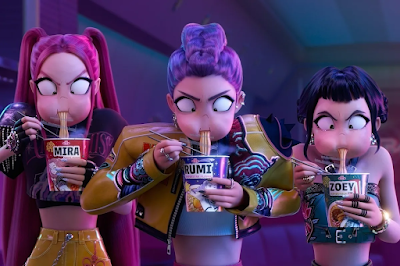K-Pop Meets Exorcism: Netflix’s Global Hit “K-Pop Demon Hunters” Fuses Idol Stardom with Traditional Korean Shamanism
What if your favorite boy band turned out to be grim reapers? And that chart-topping girl group? Secretly demon-slaying shamans by night.
This is the bold and wildly imaginative premise of K-Pop Demon Hunters, the latest anime phenomenon that has soared to the top of Netflix’s global film charts. Produced by Sony Pictures Animation, this action-packed exorcism fantasy reimagines the world of K-pop through the lens of Korea’s rich shamanistic traditions. It’s co-directed by Maggie Kang—a Korean-Canadian born in Seoul—and American director Chris Appelhans. Notably, the voice cast includes familiar names like Lee Byung-hun and Kim Yunjin, adding even more star power to the project.
At the heart of K-Pop Demon Hunters is a trio of female idols called Huntress, who dazzle fans on stage by day, and banish evil spirits by night. During their exorcisms, they don traditional Korean shaman garb, chant incantations, and wield weapons reminiscent of ritual tools seen in gut ceremonies. The visual fusion is stunning—vivid and unapologetically rooted in Korean culture.
The anime doesn’t stop at shamanic motifs. Iconic imagery like the smoking tiger from Korean folk paintings makes a memorable appearance, as does Korea’s symbolic magpie bird. The show has become such a sensation that fans are already clamoring for merchandise.
Its explosive success has sparked some online friction—especially among Chinese netizens, who, despite Netflix being blocked in China, have taken to social media accusing Korea of "stealing" Chinese culture. But such controversy only underscores the show’s cultural impact and viral reach—what some have dubbed the “dark index” of its popularity.
In K-Pop Demon Hunters, the girl group Huntress is rivaled by an all-male idol group known as Lion Boys, who embody the image of the traditional Korean grim reaper—dressed in black robes, sporting gat hats, and performing stylized fan dances, mask performances, and even traditional sangmo spinning—all with a modern, hip twist.
Beyond its stylish action and folklore-laced visuals, the anime also offers charming moments of relatability. In one scene, the Huntress members casually snack on instant Korean noodles, bridging the world of mythical demon-slaying with the everyday lives of today’s youth. This blend of tradition and modernity appeals to a broad age range, resonating with both younger audiences and nostalgic adults alike.
Ironically, while the anime is generating buzz in Korea, it seems to be gaining even more traction overseas. And while some in Korea still view shamanistic themes through a political or skeptical lens—especially in the wake of associations with past administrations—K-Pop Demon Hunters may help reframe these traditions as a valuable and vibrant part of Korea’s cultural heritage.
If nothing else, it proves that when K-culture meets bold storytelling and visual flair, the results can be spellbinding.












No comments:
Post a Comment